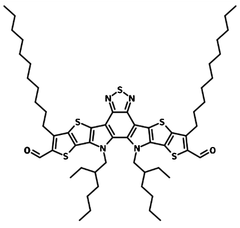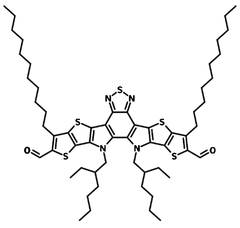TTP-TTI-2CHO
CAS Number 2304444-53-7
Carbaldehyde Monomers, Chemistry Building Blocks, Materials, MonomersTTP-TTI-2CHO, for the synthesis of highly efficient low band-gap non-fullerene acceptors
High purity monomer available online for fast, secure dispatch
Specifications | Literature and Reviews
TTP-TTI-2CHO contains a rigid core of thienothienopyrrolo-thienothienoindole (TTP-TTI), CAS number 2304444-53-7, with large side alkyl chains which help for solubility. It could also be considered as highly symmetrical with benzothiadiazole centre fused with two identical thienothienopyrrole units (BTP).
TTP-TTI-2CHO is the building block that is used for the synthesis of highly efficient low band-gap non-fullerene acceptors (NFAs) such as Y5 (BTP), Y6 (BTP-4F) and Y7 (BTP-4Cl).
Multiple alkyl side chain
Enhances solubility
High purity
>98% TTP-TTI-2CHO Purity
Worldwide shipping
Quick and reliable shipping
Symmetrical benzothiadiazole
Fused thienothienopyrrole, for the synthesis of low bandgap NFAs
General Information
| CAS Number | 2304444-53-7 |
| Chemical Formula | C58H82N4O2S5 |
| Molecular Weight | 1027.62 g/mol |
| Full Name | 12,13-bis(2-ethylhexyl)-3,9-diundecyl-12,13-dihydro-[1,2,5]thiadiazolo[3,4-e]thieno[2'',3'':4',5']thieno[2',3':4,5]pyrrolo[3,2-g]thieno[2',3':4,5]thieno[3,2-b]indole-2,10-dicarbaldehyde |
| Synonyms | BTP-2CHO, PM376, Y6-5, Y6-CHO |
| Classification / Family | Thienothienopyrrolo-thienothienoindole (TTP-TTI) derivatives, Organic semiconducting materials, Semiconductor Synthesis, Low band gap polymers, OFETs, OLED, Organic Photovoltaics, None-fullerene acceptors (NFAs), NFA-OSCs. |
Chemical Structure

Product Details
| Purity | >98% |
| Melting Point | N/A |
| Appearance | Orange red powder |
Literature and Reviews
- Eco‐Compatible Solvent‐Processed Organic Photovoltaic Cells with Over 16% Efficiency, L. Hong et al., Adv. Mater., 1903441 (2019); doi: 10.1002/adma.201903441.
- Over 16% efficiency organic photovoltaic cells enabled by a chlorinated acceptor with increased open-circuit voltages, Y. Cui et al., Nat. Commun., 10:2515 (2019); DIO: 10.1038/s41467-019-10351-5.
- Green-solvent-processable strategies for achieving large-scale manufacture of organic photovoltaics, Z. Ma et al., J. Mater. Chem. A,7, 22826-22847 (2019); DOI:10.1039/C9TA09277C.
